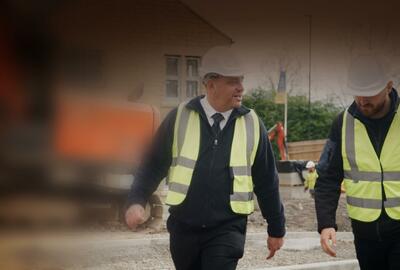Looking back to summer 2019, it was evident that there was a change in productivity for the UK’s construction industry. We’re used to seeing an increase, every summer, of an influx of new roles being filled, new opportunities being created and new projects kicking off in major towns and cities across the country. Work has been slowing however - last summer we only saw 16% of the year’s placements made during those months, when we’re used to seeing at least 30%.
Brexit has a lot to answer for. With such a large period of uncertainty surrounding Brexit last year, with daily questions about will it happen? Won’t it happen? Do we even know anymore? The only thing we were certain about was uncertainty. This played havoc on the construction industry, and the jobs market in general. Workload predictions were very volatile as clarity on what a post-Brexit sector would look or feel like was non-existent. Our clients were unsure as to how many workers they would need, what projects they would be starting and what projects might need to be put on hold due to cost-cutting.
The differing levels of optimism across the country were prompting discussions about the jobs market forecast, and dividing opinions. When we ran a survey last year of over 10,500 construction workers, we discovered that one in three EU nationals were considering leaving the UK because of Brexit. Fast-forward a year, and opinions are much the same and we’re only just leaving, over three and a half years after the referendum was held.
Yesterday, Chancellor Rishi Sunak shared some big spending plans for the UK in the 2020 budget announcement. Some promising news for the construction industry in general, with £600 billion investment presenting an exciting opportunity to “get Britain building”, as we heard yesterday. Presenting some welcoming news for infrastructure, specifically roads and rail, with a spotlight on housing.
However, employers and employees are still sceptical of what the industry will look like later this year in terms of workforce and materials supply. With £10bn of the UK’s building materials coming from the EU, it’s those figures that are causing concern. This includes £1bn of timber and £750m of aluminium products, equating to 15% of products used in UK construction. On top of that, the construction materials price index increased 5.3% on the year in January, forcing up the cost of net imports from the EU. Cost aside, the industry has also raised concerns over the potential speed of imports post-Brexit to support current projects.
Some sectors still managed to push on amid uncertainty. Private housing remains high on the agenda; with the extension of the government’s help-to-buy scheme to 2023, housebuilders still need skilled labour. Yesterday’s budget announcement unveiled plans to commit to a £10.9 billion increase in housing investment to support the commitment to build at least one million new homes by the end of the Parliament, and an average of 300,000 homes a year by the mid-2020s, further boosting confidence.
At the other end of the spectrum, the UK’s high end infrastructure projects enable the sector to reach its highest levels. This is driven by top-tier projects such as Thames Tideway, Hinkley Point C and of course, HS2. The multi-billion pound project has received strong opposition from local communities, and speculation about how much the government are spending is under constant scrutiny. Despite criticism however, and campaigning for the project to be scrapped, recently the PM confirmed that HS2 will get the go-ahead, stating that the government had given a clear commitment to level up parts of the UK, which HS2 plays an important role in.
As well as the new pledge to invest £20 million to develop the Midlands Rail Hub as part of yesterday’s budget announcement, recent news of the £500 million pledge to bring back historic rail lines, improving connectivity for communities across the country has been well received. The Beeching cuts in the 60s saw communities across the UK suffer from isolation soon benefit from better connectivity, allowing easier access to jobs and education. The proposed funding includes £20m for the New Stations Fund, £1.5m for the Ashington-Blyth-Tyne line, £300,000 for the ‘Ideas Fund’ and £100,000 for the Fleetwood line. This will in turn, create hundreds of jobs. Last year, around 20 percent of the workforce employed in the rail sector were non-UK EU nationals according to findings published by the House of Lords, who said it welcomed all initiatives that would improve training opportunities in Britain. However, with rail projects ramping up such as the restoration of multiple lines through £500 million investment and development of HS2, the government needs to work with specialist agencies and bodies to create a sufficient supply of skilled workers. The Railway Industry Association said it was working closely with the National Skills Academy for Rail, which was “generating new apprenticeship courses to fill that gap”.
With regards to next steps for the industry in general, we need that next layer of clarity. We now need to know exactly what the impact will be on workers’ rights and movements, so we can try and calculate and cater for loss of economic strength as a result of Brexit uncertainty.
Now that Brexit is going ahead, perceptions are changing. The ‘Boris bounce’ is already contributing towards the reshaping of the housing sector as consumer confidence rises - the uncertainty was the issue and the root cause of the problem. Very recently we’re noticing an uplift in intertest from candidates and clients. Workers seem to be more interested in moving roles again - we’re moving on from the previously stagnant market and ready to get going.
As we seek more clarity in the upcoming months about the freedom of movement and what exactly it will look like for EU nationals, we’ll be able to make firmer plans. Our findings from last year suggested that over a third of EU nationals were considering leaving due to Brexit, so if this is the case, we need to be prepared plug the potential loss of workers - it’s imperative to tap into all the talent pools available. This signals a prized opportunity for the industry and employers to harness and retain a sizeable proportion of their existing workforce.
For our 2020 women in construction report we asked candidates what could be done to persuade more women to join the construction industry, or stay in their role if they are already working in. Unsurprising equal pay came out on top, from both a male and female perspective. The gender pay gap continues to be an issue across the country’s workforce in general, with the overall pay gap standing at 17.3% (ONS, 2019). Progress towards closing the gap in recent years has been slow, and has occurred against a backdrop of declining real wages, meaning that a narrowing in the GPG has come at the expense of wage growth for both men and women.6 With construction remaining a male-dominated industry, the stigma still very much stands. 18% of respondents ranked equal pay as the factor which would have the biggest impact on retaining and attracting a female workforce.
The next 18 months are critical for women in construction and employers need to be ready to accommodate and update outdated policies where appropriate. Not only do we need to drive project momentum but we need to ensure that we don’t take our fingers off the diversity pulse - It’s something we can achieve together which will help continue to drive the industry forward post-brexit.






